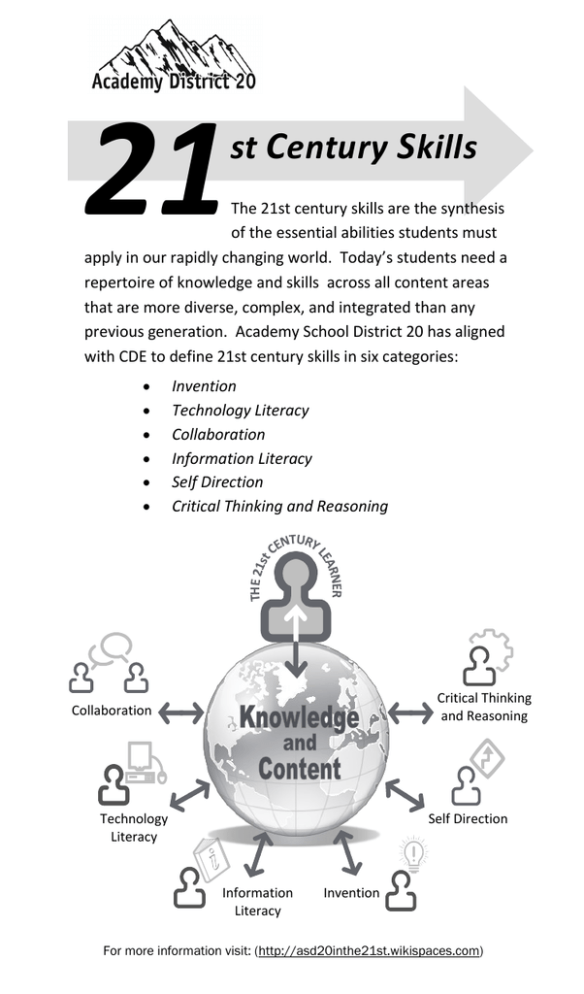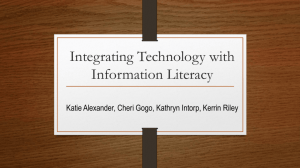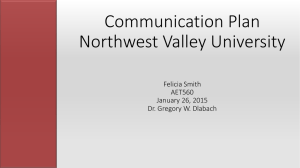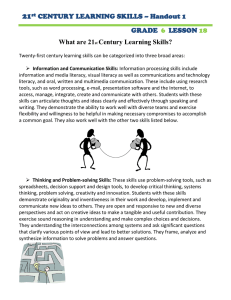21 st Century Skills - Academy District 20
advertisement

21 st Century Skills The 21st century skills are the synthesis of the essential abilities students must apply in our rapidly changing world. Today’s students need a repertoire of knowledge and skills across all content areas that are more diverse, complex, and integrated than any previous generation. Academy School District 20 has aligned with CDE to define 21st century skills in six categories: Invention Technology Literacy Collaboration Information Literacy Self Direction Critical Thinking and Reasoning Critical Thinking and Reasoning Collaboration Technology Literacy Self Direction Information Literacy Invention For more information visit: (http://asd20inthe21st.wikispaces.com) PAGE 2 Invention Students engage in mental and social processes to generate new ideas and concepts, and new associations between existing ideas and concepts, leading to new ways of doing things that can change thinking, processes, and products. Students: Tap in to multiple intelligences. Participate in authentic learning experiences and reflection. Create new products and processes. Express themselves artistically. Thrive when given a choice in process and product results. Use higher level questioning. Use applied imagination through the Imagine Create Play Share Reflect Imagine process. Apply new ways to solve problems. STUDENTS NEED TO PERSONALLY CONSTRUCT THEIR OWN KNOWLEDGE BY POSING QUESTIONS, PLANNING INVESTIGATIONS, CONDUCTING THEIR OWN EXPERIMENTS, AND ANALYZING AND COMMUNICATING THEIR FINDINGS. (NCR, 1996; AAAS, 1990, 1993; NATIONAL COUNCIL OF TEACHERS OF MATHEMATICS [NCTM], 1991; ROSENSHINE, 1995; FLICK, 1995) Technology Literacy Students responsibly use the appropriate technology to communicate; solve problems; access, manage, integrate, evaluate, design, and create information to improve learning in all subject areas and to acquire lifelong knowledge and skills in the 21st century. Students : Apply technology effectively. Use digital technologies (Computers, media players, PDA’s, GPS, etc), communication/networking tools appropriately to access, manage, integrate, evaluate and create information. Develop an awareness of technology-related careers and of factors critical to success in those careers, as well as an understanding of and sensitivity to societal issues related to technology. Use innovative ways of applying technology in challenging new situations. Use social media and other electronic tools to communicate and collaborate with people in other nations. Communicate responsibly in awareness of their digital footprint. Use technology as a tool to research, organize, evaluate and communicate information. PAGE 3 THE NET GEN READILY TAKES PART IN COMMUNITY ACTIVITIES. GIVEN A CHOICE, THEY SEEM TO PREFER WORKING ON THINGS THAT MATTER, SUCH AS ADDRESSING AN ENVIRONMENTAL CONCERN OR A COMMUNITY PROBLEM. THEY BELIEVE THEY CAN MAKE A DIFFERENCE AND THAT SCIENCE AND TECHNOLOGY CAN BE USED RESOLVE DIFFICULT PROBLEMS. EDUCASE, 2005. Collaboration Students engage with others using both digital media and face-to-face interactions as they work together to master content, learn about themselves and their environment, and contribute to their personal success and the success of others. Students: Interact, collaborate, and publish with peers, experts, or others employing a variety of digital environments and media. Collaborate beyond the school walls with people of varying ages, academic backgrounds and social groups. Offer ideas, strategies, solutions, justifications, and proofs for others to evaluate as well as interpret and evaluate the ideas, strategies, solutions, and justifications of others. Contribute to project teams to produce original works or solve problems. Develop cultural understanding and global awareness by engaging with learners of other cultures. Information Literacy Students identify information needs, seek out reliable resources to meet those needs, and then analyze, synthesize, evaluate, and communicate the resulting knowledge. Students: Find, evaluate, and select appropriate resources and information. Manage and make sense of data from print and electronic sources, primary and secondary. Acquire a fundamental understanding of the ethical/legal issues surrounding the access and use of information. Seek out diverse perspectives and points of view to better understand problems and issues, local and global, past and present. THE BOARD ON CHILDREN, YOUTH, AND FAMILIES, WHICH PRODUCED THE 2004 NATIONAL RESEARCH COUNCIL REPORT, OFFERED A RESEARCH-BASED SET OF RECOMMENDATIONS FOR WHAT WE CAN DO TO KEEP YOUNG PEOPLE IN SCHOOL, MAKE HIGH SCHOOL MEANINGFUL, AND KEEP STUDENTS ENGAGED AND MOTIVATED. THE IDEAS INCLUDE: (CONTINUED BOTTOM OF PAGE 4) PAGE 4 Self Direction Students will acquire and use fundamental skills that are necessary for learning to occur and for lifeSTUDENTS NEED TO HAVE long success. Students: OPPORTUNITIES TO PRO- Demonstrate flexibility and adaptability by applying what they learn to a variety of situations. Collect data to track their own progress to monitor and adjust their learning strategies. Exhibit productivity and accountability when they complete products on time to express learning. Show leadership and responsibility when they actively participate in school, district & community activities. Show respect for differing opinions, interests and experiences. GRESS FROM CONCRETE TO ABSTRACT IDEAS, RETHINK THEIR HYPOTHESES, AND RETRY EXPERIMENTS AND PROBLEMS (NRC, 1996; AAAS, 1990, 1993; NATIONAL COUNCIL OF TEACHERS OF MATHEMATICS [NCTM], 1991; ROSENSHINE, 1995; FLICK, 1995) Make environmentally responsible choices. Set challenging personal goals. Reflect on their own learning and refocus their efforts accordingly. Critical Thinking & Reasoning Students engage in purposeful and reflective evaluations and judgments about what to believe or what to do in response to observation, experience, and communication. Students: Use purposeful and reflective evaluation and judgments based upon evidence. Identify authentic problems and questions for investigation. Maintain a critical stance by questioning the validity, seeking divergent perspectives, and accuracy of information. Use their knowledge to solve problems through active involvement in local and global communities. Analyze evidence, draw conclusions, make informed decisions, apply knowledge to new situations, and create new knowledge. (CONTINUED FROM THE BOTTOM OF PAGE 3) FORMING A GOOD CONNECTION BETWEEN A LEARNER AND THE SOCIAL CONTEXT IN WHICH LEARNING WILL TAKE PLACE; AND MAKING “THE CURRICULUM AND INSTRUCTION RELEVANT TO ADOLESCENTS’ EXPERIENCES, CULTURES, AND LONG-TERM GOALS, SO THAT STUDENTS SEE SOME VALUE IN THE HIGH SCHOOL CURRICULUM.” EDUCASE, 2005. PAGE 5 How do you increase 21st Century Learning? DO MORE OF THIS: DO LESS OF THIS: STRATEGIES THAT ACTIVATE PRIOR KNOWLEDGE TEXTBOOK DRIVEN INSTRUCTION TESTING AND MAKING PREDICTIONS SOLITARY SEATWORK HOLISTIC, HIGHER-ORDER THINKING SKILLS STUDENT OWNERSHIP AND RESPONSIBILITY REAL PURPOSES AND AUDIENCES FOR WRITING COLLABORATIVE GROUP WORK EVALUATION FOCUSED ON INDIVIDUAL, LOWLEVEL SUB SKILLS EVALUATION BASED SOLELY ON TEST SCORES ISOLATED LESSONS ON SKILLS WITHOUT CONTEXT “TURNING IT IN,” AS OPPOSED TO PUBLISHING FOR REAL AUDIENCES CUMULATIVE VIEW OF GROWTH AND SELF- STRESSING OF MEMORIZATION AS OPPOSED TO EVALUATION UNDERSTANDING ACTIVE EXCHANGE AND VALUING OF STUDENTS’ IDEAS PROBLEM-SOLVING APPROACH TO INSTRUCTION QUESTIONING AND MAKING CONJECTURES FACILITATION OF LEARNING DEPTH OF LEARNING WITH FEWER OBJECTIVES FORMATIVE EVALUATION TESTING EXCLUSIVELY FOR GRADES ROTE MEMORIZATION OF FACTS WITHOUT CONTEXT FOCUSING ON LARGE NUMBER OF ISOLATED SKILLS RIGIDLY FOLLOWING CURRICULUM BROAD COVERAGE OF UNCONNECTED FACTUAL INFORMATION TEACHER TAKING ON FINAL AUTHORITY AND RESPONSIBILITY FOR STUDENT LEARNING BUILDING UNDERSTANDING OF CONCEPTS INCLUDING EVERYTHING WITHOUT ALLOWING THROUGH REFLECTION TIME FOR DEEPER UNDERSTANDING OF TOPICS PROJECT-BASED LEARNING LECTURING REAL-WORLD APPLICATIONS EXCLUSIVE USE OF SUMMATIVE EVALUATION PROVIDE CHALLENGING OPPORTUNITIES FOR LEARNING MEASURING SUCCESS ONLY BY TEST SCORES BACKWARDS DESIGN EXCLUSIVE USE OF WHOLE-CLASS INSTRUCTION LEARNING ACTIVITIES BASED ON ESSENTIAL QUES- SENSE OF CLASS AS A GROUP OF COMPETING TIONS INDIVIDUALS INTEGRATION OF SUBJECT AREAS “DISPENSING” KNOWLEDGE UNDERSTANDING AND RESPONDING TO STUDENT INTEREST ACTIVITIES THAT ENGAGE STUDENTS IN INQUIRY AND PROBLEM SOLVING ABOUT SIGNIFICANT HUMAN ISSUES LOOKING FOR THE “RIGHT ANSWER” ASSESSING STUDENTS ONLY AT THE END OF A GRADING PERIOD OR PROJECT INTEGRATION OF THE ARTS TEACHING BY TELLING USE OF TECHNOLOGY TOOLS AND SKILLS ASSESSING ONLY WHAT IS EASY TO MEASURE Zemelman, Steven, Harvey Daniels and Arthur Hyde. (2005). Best practice: Today’s standards for teaching & learning in America’s schools. Portsmouth, NH: Heinemann. PAGE 6 Sources American Association of School Librarians. (2007). Standards for the 21st century learner. Retrieved from http://www.ala.org/ala/mgrps/divs/aasl/ uidelinesandstandards/learningstandards/AASL_LearningStandards.pdf Creativity. (n.d.). In Wikipedia. Retrieved November 11, 2009, from http://en.wikipedia.org/wiki/Creativity Educase. (2005). Educating the net generation. Retrieved from http://net.educause.edu/ir/library/pdf/pub7101.pdf. Ewan McIntosh |Digital Media & Education. (2007, July). MIT's Mitch Resnick: Tools for Creative Thinking. [Web log message]. Retrieved from http://edu.blogs.com/edublogs/2007/07/mits-mitch-resn.html Innovation. (n.d.). In Wikipedia. Retrieved November 11, 2009, from http://en.wikipedia.org/wiki/Innovation International Society for Technology in Education. (2007). The ISTE national educational technology standards (NETS.S) and performance indicators for students. Retrieved from http://www.iste.org/Content/NavigationMenu/ NETS/ForStudents/2007Standards/ NETS_for_Students_2007_Standards.pdf Jarrett, Denise. (1997, May). Inquiry strategies for science and mathematics learning: It’s just good teaching. Northwest Regional Educational Laboratory. Retrieved from http://educationnorthwest.org/webfm_send/203 Partnership for 21st Century Skills (2009). P21 framework definitions document. Retrieved from http://www.21stcenturyskills.org/documents/ p21_framework_definitions_052909.pdf Schacter, John. (1999) The impact of education technology on student achievement: What the most current research has to say. Milken Exchange. Retrieved http://www.mff.org/pubs/ME161.pdf Thomas & Knezek. (1995). Technology Literacy for the Nation and for Its Citizens. Tubbs, Jamie. (n.d.). Cultivating creativity in the classroom. Retrieved November 11, 2009 from Slideshare website: http://www.slideshare.net/jtubbs/ cultivating-creativity-in-the-classroom. Zemelman, Steven, Harvey Daniels and Arthur Hyde. (2005). Best practice: Today’s standards for teaching & learning in America’s schools. Portsmouth, NH: Heinemann. FIRST PRINTING FEB 2010 IT– Educational Services Colorado Springs, Colorado



